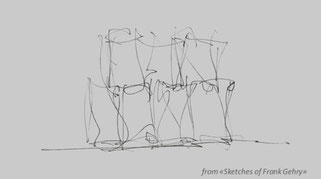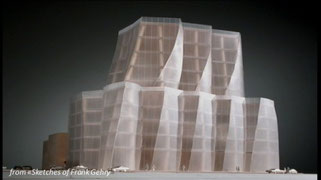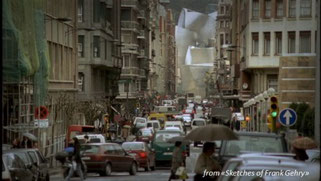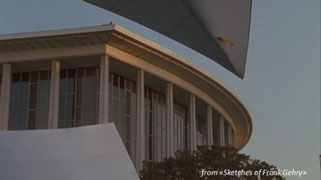The architect that makes the shapes dance

In 2005 the documentary , Sketches of Frank Gehry (in Italian Frank Gehry creatore di sogni) of Sydney Pollack came out. As soon as I saw it I realized the happy coincidence of three elements: a simple and honest way Frank Gehry talks about his projects , how they change over the years, and the testimony of his psychotherapist who talks about some aspects of his psychotherapy.
Here's an example of a transformation process. By this, I’m not saying that everyone who goes through psychotherapy should become like Frank Gehry. Everyone has their own talents and if we were trees, everyone could become a pine, an oak or a cypress depending on the talent that one has within.
This documentary is a good example of how psychotherapy can liberate new energy to be more free and in Frank Gehry’s case, to be more creative.
I propose some pieces of the documentary, selected and arranged by theme.
Architect or artist?
"My colleagues that were architects, mostly my age, made fun of me. I never had a shred of support from them but rather a detached curiosity. With the artists instead I had fun. I loved them and their works, they treated me as a family member . "
(from Sketches of Frank Gehry - S. Pollack 2005)
His house
"It was Berta (his wife) to find the house, it was comfortable, had a little garden and we could afford it. When I bought it I realized that I had to do something before moving in. And I loved the idea of leaving the house intact and not messing with it. It was around the old building that I realized the new building. I wanted the windows to stretch out of the building. "
(from Sketches of Frank Gehry - S. Pollack 2005)
The idea of taking Frank Gehry as an example of transformation came looking at his house. Usually a house in dreams represent the psychic space of the dreamer.
Frank Gehry describes it as an older inner core with windows that stretch out, outside of the building.
If we look at it, starting from the exterior part of the building, we can see areas of light entering an older inner core. And this, according to a psychological interpretation, is the integration of parts of one’s self, the integration of new parts with the older parts, illuminate parts with darker parts.
The courage to change
"While I was building my house, I completed the Santa Monica Place, a shopping center. The night of the inauguration we had dinner here at home with the company president, a lawyer, who looked around and asked, 'What the hell is this?' And I 'Well, I had fun experimenting a bit' '. And he 'Do you like it? You must like it.' And I 'I do' and he 'If you like this you can’t like that’ and pointing his finger at the Santa Monica Place. To which I say, 'You're right, I don’t.' And he says, 'Then why did you do it?' And I 'To make a living' and he, 'Stop it, you should stop it' and I 'You’re right'. At that time there were 45 people in my office working on projects for him, and with a handshake we decided to stop everything. I had an amazing feeling like jumping off a cliff and despite all the troubles, I found happiness. "
(from Sketches of Frank Gehry - S. Pollack 2005)
Psychotherapy
"Milton Wexler, Frank Gehry’s psychotherapist: 'I’ve known Frank for 35 years. In the beginning, as a patient, he
had no self confidence, he often said to be bankrupt and was not only referring to money, but also about his social life and his ability to get his clients to accept the things he was
doing.
His eyes embodied the figure of an adult, true or not, this is how he saw me. Later, when he realized that our roles were changing, that in some way he was becoming the teacher, because I knew very little about art and architecture, this helped him to take the less gregarious role in our relationship and in the relationship with his clients. He began to teach them as if he was teaching me, to tell them what they needed to see and how they needed to see it. In this sense my ignorance constituted a valuable asset in the therapy.
Many think that I made Frank a great architect, which is nonsense. I didn’t make him famous, if anything the opposite. As a matter of fact, when Frank became a celebrity many architects asked to become my patients but I always refused because I knew perfectly well that I could not make them Frank Gehrys. I can open the floodgates, but if there’s no water ...
There is something in the right hemisphere of his brain that allows him to indulge in free association which then can translate into concrete objects. The more he gained security in his social life, the more he was determined to venture the unknown. "
(from Sketches of Frank Gehry - S. Pollack 2005)
Creativeness
The formula of architecture of Frank Gehry can be summarized, as he says, in X minus something and X plus
something. It’s geometry of curved surfaces applied to architecture.
Frank Gehry says: "... This chaos that you start feeling, is nice."
"Philip Johnson, architect: if there's one thing that Frank can interpret is the light, everything is in the way in which the shape of the light as it hits another shape, everything else is peripheral, the architecture itself is peripheral.
Frank Gehry: “ ... what prevails making me forget all incidents along the way, is the way in which materials reflect light adding a dimension that was absent in the drawings and scale models, and everything comes to life. "
"Barry Diller, chairman, CEO, IAC / Interactive Corp.: we started talking about water because Frank, as myself, likes boats, and I was going to a launch one. I confided my dream, I took my new boat to the mouth of the Hudson, passed under the Verrazano bridge, passed Battery park, sailed up the Hudson again and on the river bank this building suddenly appeared to me. A moment later Frank threw down two scribbles, the essential was already there. He had created the sails."
"Frank Gehry: 'If I accept a job it’s because I like people who are offering it to me'.
Mildred Friedman, writer, curator: 'Frank understood something that many of his colleagues do not realize, what most influences the project is the client. If there is a big client, you can make a big building, otherwise not'."
(from Sketches of Frank Gehry - S. Pollack 2005)
A memory
"I always liked working with my hands, I still remember, I must have been eight years old, my grandmother had a bag full of carpentry scraps with which she fed the stove and occasionally it
toppled to the ground and with those sticks we built roads and palaces. I had so much fun. And when I was faced with the dilemma of what I wanted to be when I grew up, I kept
remembering that game and intuitively I thought : maybe I should do something like that."
(from Sketches of Frank Gehry - S. Pollack 2005)
Guggenheim Museum - Bilbao
"Sidney Pollack: ... 'I've never seen anything like the museum in Bilbao, the sensuality, the musicality where they come from' ... Frank Gehry: 'simple evolution, I was looking for a way to express emotions in three-dimensional objects, when you enter the cathedral of Chartres it obligates you to
kneel.'
Norman Rosenthal, exhibition curator, Royal Academy, London: for me the most impressive cathedral of the twentieth century is the museum in Bilbao. There's no doubt, it takes your breath away,
it's like taking a glimpse of paradise.
Juan Ignacio Vidarte, director of the Guggenheim Museum in Bilbao: someone said, I think it was a British journalist, that the museum seems an object from space but it landed here 100 years ago, so it's alien because it has nothing in common with the surrounding buildings, but at the same time has the characteristics that make it belong to these places. If it weren’t here now, no one would understand the city of Bilbao.
Nerea Abasolo, journalist, Bilbao: the urban area counts 350,000 inhabitants, well only the first year we welcomed 700,000 tourists. It has developed a form of collective pride, admiration for the architect to the pleasure of being so far-sighted to realize his project, to the satisfaction of having a building that the whole world envies.
Frank Gehry: I did not expect that the museum in Bilbao to draw so much success, so much that the inauguration was full of doubts and I thought 'My God, what have I done!'
Seeing the museum in Bilbao finished I felt embarrassed: 'Oh Lord, but was he thinking letting me do it!' "
(from Sketches of Frank Gehry - S. Pollack 2005)
Maggie's Center - Dundee
"The Maggie's Centre is the project I did for free in memory of a friend. I started with an idea, then I started dreaming
of Maggie telling me that there was too much architecture, that I had to tone it down, so I threw away everything and I started over.
Chales Jenckes, architect, husband of Maggie Keswick: Having worked with Maggie, Frank was able to grasp the meaning of the initiative: to offer cancer patients an informal space. He agreed to cover the entire cost of the project because he was a great friend of Maggie and their friendship resulted in a conception of architecture as a healing tool. Non-institutionality , informality, a friendly atmosphere and places for reflection are the key elements of the center. It 's a nice place to wake up in the morning and admire the landscape.
It is very important for cancer patients to see the disease in a context which is bigger than themselves."
(from Sketches of Frank Gehry - S. Pollack 2005)
Walt Disney Concert Hall - Los Angeles
"Frank Gehry: The forms of Disney Hall are inspired by boating. With butterfly sails, when you’re wing-on-wing, with the wind behind you, it creates a beautiful space. If you look at the front of Disney Hall it’s wing-on-wing, it’s the two sails, and you are at the helm.
Esa-Pekka Salonen, director of the Los Angeles Philharmonic: regardless of the aesthetic result, a room that does not sound good has failed its purpose and Frank was explicit from the beginning on this point: this is building for music, this has to be the first priority, everything else is of lesser importance. Quite a statement for an architect.
Frank Gehry: The architect must be optimistic about the relationship between his work and the surrounding buildings. ... I do not like the Dorothy Chandler Pavilion, it is not that special but it exists, for the people it means something, it’s part of the community.
So, whether I like it or not I have to respect that. It’s like being a good neighbor. So I have tried to make
something that does not belittle the value of the iconic Dorothy Chandler Pavillion and I decided to break down the scale of the Disney Hall into smaller pieces, differentiating the
language."
(from Sketches of Frank Gehry - S. Pollack 2005)
Reflections
"Frank Gehry: When I receive negative comments I do what I would do with a pair of jeans, I try them, in the sense that I want to understand if I can somehow benefit , but not assimilate them
intellectually, I don’t say from now on I will do it like this instead of that. and then I go on my own way.
Sydney Pollack: do you ever feel sad at the end of a job?
Frank Gehry: like postpartum depression? Well ... yes ... the separation is difficult. For me, it takes a year, then when I see that everything works, that people appreciate it, I let myself go a bit '.
Sydney Pollack: Do you ever wonder how you did it?
Frank Gehry: yes, every time. But how the hell did I do it?
Berlin, DG Bank - Frank Gehry: I do not live in Berlin so I’m only going to see it today and maybe I’ll see it another 3 or 4 times in my life, for me it’s like one of my children, I love it.
Frank Gehry: When you start a career as an architect, you seek an impossible perfection and go through life thinking about this ideal building that would be great to build, the capstone of my career, then you realize, as you mature, that you’re never going to get ‘there’ because there is no ‘there’. "
(from Sketches of Frank Gehry - S. Pollack 2005)
Frank Gehry affects us the way he narrates, he shows us his emotions with honesty, something that we rarely encounter in famous people. The fatigue that makes letting go of his creature, like every parent with their child who begin their own life. The embarrassment that he feels when he concludes one of his projects: "Oh God, how could you let me do this!"
Often his work is inspired by dreams. It was Maggie’s dream that changed the design of Maggie's Center. It was his client’s dream that designed the IAC building in New York. And you know, dreams are the best way of communicating with the unconscious.
His psychotherapist Milton Wexler says that 'there is something in the right hemisphere of his brain that allows him to indulge in free association which then translates into concrete objects'. As if he favored a non-verbal language, for images and emotions. I really like his search on how to be able to express emotions in three-dimensional objects. The cathedral of Chartres says: 'when you enter, it forces you to kneel'.
Milton Wexler, his psychotherapist, tells us that 'at the beginning, as a patient, he had no self confidence', from his works and how he narrates you can imagine that he has achieved a good degree of freedom: the freedom to be hisself.
This is not to create the myth of Frank Gehry, this is just one example. Each patient has his own path. The transformation is a process that often turns out in retrospect, looking back and realizing how it changed since then. The transformation can be realized by acquiring new horizons and new visuals, emotional changes or in the way we show respect to others, even without becoming a celebrity.
Paola Palmiotto
Clicking on the images you can see them enlarged












